
Lhasa or Chengguan is a district and administrative capital of Lhasa City in the Tibet Autonomous Region of China. The inner urban area of Lhasa City is equivalent to the administrative borders of Chengguan District, which is part of the wider prefectural Lhasa City.

Shigatse, officially known as Xigazê, is a prefecture-level city of the Tibet Autonomous Region of China, with an area of 182,000 km2 (70,271 sq mi). It is located within the historical Tsang province of Tibet.
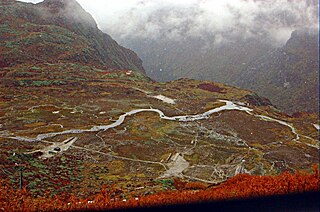
Yadong County, also transliterated from Tibetan as Chomo County, is a frontier county and trade-market of Tibet Autonomous Region, China, situated in the mouth of the Chumbi valley near the China-India and China-Bhutan border. It lies in the middle part of Himalayas and the south of Tibet Autonomous Region, covering about 4,306 square kilometers with a population of 10,000. It is under the jurisdiction of Xigazê.

Shin-Koyasu Station is a railway station operated by East Japan Railway Company located in Kanagawa-ku, Yokohama, Japan.
The Lhasa Hotel is a modern accommodation built in the city of Lhasa, Tibet, China; a 4-star hotel lying at an altitude of 3,600 m. It is located northeast of the Norbu Lingka Summer Palace in western Lhasa.

Zêtang, also Zedang or Tsethang, is the fourth largest city in Tibet and is located in the Yarlung Valley, 183 km (114 mi) southeast of Lhasa in Nêdong District of Shannan, Tibet Autonomous Region of China. As capital of Shannan City, it "...exercises direct control over the affairs of 13 counties: Gongkar, Tranang, Nedong, Changye, Tso-me, Lhodrok, Nakartse, Zangri, Chutsum, Lhuntse, Tsona, Gyatsa and Nang."
Mount Gephel is a small Tibetan mountain located 8 kilometers west of Lhasa in Tibet. Drepung Monastery lies at its foot.

Damxung railway station is a railway station on the Qinghai–Tibet railway line in Damxung County, Lhasa, Tibet.
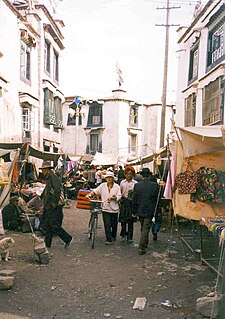
The Barkhor is an area of narrow streets and a public square located around Jokhang Temple in Lhasa, Tibet, China.
Zongxoi is a village in the Tibet Autonomous Region of China with a latitude (DMS) of 29° 58' 0 N and a longitude of 91° 16' 0 E. It lies at an altitude of 3,936 metres.
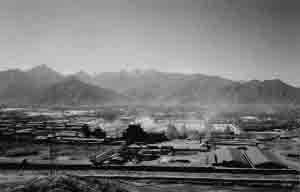
Drapchi Prison, or Lhasa Prison No. 1, is the largest prison in Tibet, China, located in Lhasa.
Ramba is a village and township in the Tibet Autonomous Region of China. It is located 107 kilometres south of Lhasa in Rinbung County, Shigatse Prefecture. There is also a lake, Ramba Co in the area.
Horru is a village in Damxung County in the Lhasa Prefecture of the Tibet Autonomous Region of China. It lies just to the east of Damxung and is connected directly by road.

Kunggar or Maizhokunggar is a small town and seat of Maizhokunggar County in the Lhasa Prefecture in the Tibet Autonomous Region of China. It is especially noted for its pottery, which non-corrodible, heat retaining and in an ethnic style. It has a more-than-1000-year-old history.

Zaxoi is a small town and township in Maizhokunggar County the Lhasa Prefecture in the Tibet Autonomous Region of China.

Tsomon Ling, Tsomonling, Tsome Ling, Chomoling is a temple in inner Lhasa, Tibet, China, south of the Ramoche Temple, and on the corner of one of the main roads, Dekyi Shar Lam. It was one of the Four Royal Colleges or Regency Temples of Lhasa built during the 17th century after the Fifth Dalai Lama assumed both temporal as well as spiritual power. The other three Ling are Tengye Ling, Kunde Ling, and Drib Tsemchok Ling.
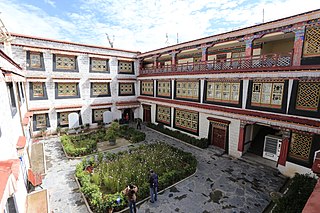
Tromzikhang, is a historic building in Barkhor, Lhasa in Tibet, China. It is located northwest of Jokhang temple at the corner of the left side of Barkhor Tromshung Jang (street). It was demolished in the 1990s except for the magnificent facade. Today Tromzikhang is a notable market in Lhasa and a housing complex.
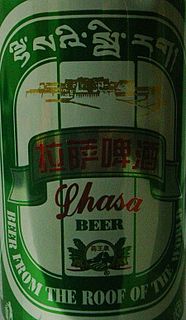
The production of beer in Tibet is a relatively recent phenomenon in Tibetan cuisine. The Chinese established the Lhasa Brewery Company in 1988, which is located in Lhasa. It is the highest brewery in the world.
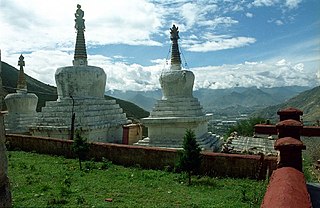
Nyang bran is a suburb district and valley located several kilometres north of the city of Lhasa, Tibet. The valley is noted for its hermitages, belonging to the Sera Monastery, one of the three great historical monasteries of Tibet. Pabonka Hermitage, Drakri Hermitage, Chupzang Nunnery and many others are located in the valley which offers scenic views of Lhasa. Mount Parasol lies on its western side on which the Pabonka Hermitage is located.

Cona, also Dongaii Cona or Tsonag Lake, is a major lake of northern Tibet Autonomous Region, China and is It is located in Amdo County, west of the road between Nagqu Town and Amdo Town. The lake is considered holy to the Tibetans especially in the Bon religion, as it is seen as the "soul lake" of the Razheng Living Buddha. The smaller Ganong Lake lies almost adjacent to the southeast.



















